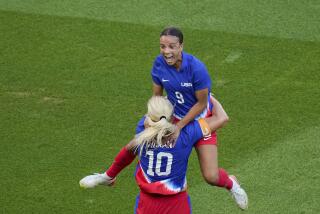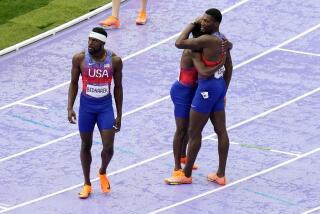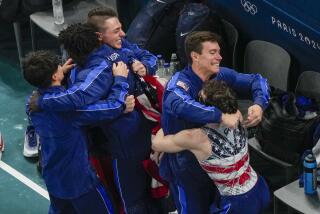U.S. Lugers Make a New Double Play
- Share via
PARK CITY, Utah — Four years ago, the U.S. Olympic doubles luge teams provided history. Friday, they provided an encore.
In the long run, the latter is more important for an American luge program that until the 1998 Games at Nagano had never produced an Olympic medal. Chris Thorpe and Gordy Sheer won a silver medal there, and Mark Grimmette and Brian Martin added bronze. On Friday at Utah Olympic Park, Grimmette, Martin and Thorpe helped prove U.S. luge prosperity might be here to stay, sliding to medals for the second time.
This time Grimmette and Martin won the silver medal, and this time Thorpe rode with Clay Ives, a two-time Canadian Olympian who became a dual citizen after the Nagano Games, for the bronze medal.
In another echo from Nagano, Friday’s American lugers watched a German sled finish ahead of them. In ‘98, the winners were Stefan Krausse and Jan Behrendt, who retired. On Friday Patric-Fritz Leitner and Alexander Resch won the gold medal.
Leitner and Resch broke their own track record with a time of 42.953 seconds on their first run, despite having the field’s fifth-best starting time and brushing the wall coming off the final curve. In their second run, they had just the 13th-best start but drove the course deftly and finished with a total time of 1:26.082, .134 seconds ahead of Grimmette and Martin.
Thorpe and Ives broke their own track start record with a 3.045-second effort on their first run to lead Grimmette and Martin by .098 in the race for the silver medal. But Thorpe drove “a little too tight” on his second run, and he and Ives finished in 1:26.220, just .004 of a second--or literally inches--behind their teammates.
Only weeks ago, it seemed doubtful either duo would stand on the medal podium, as both teams struggled through the early stages of the World Cup season. Through the first six of the circuit’s seven races, the best Grimmette and Martin could manage was two third-place finishes, and the best Thorpe and Ives could do was a seventh. In the World Cup finale late last month, Thorpe and Ives catapulted to second place, but Grimmette and Martin slid to 14th.
Thorpe and Ives, who joined forces after Sheer retired in 2000 and Ives left the Canadian luge program for lack of financial support, were still adjusting to each other. Grimmette and Martin were struggling to find the right sled setup.
Friday it all came together, even though Thorpe, who’s retiring, said he was “never that nervous in my life,” more nervous than he expects to be next month when his wife, Kriste, gives birth to their first child. Ives tried to calm his partner.
“I told him, ‘Kriste is going to have a baby in a couple weeks,’” Ives said. “‘If she can do that, we can do this. Let’s put down a good one.’”
Seasoned by competition and travel, Ives enjoys public speaking, especially in front of student groups. He thought about those talks Friday morning.
“We always say competing and being a competitor is what’s important and winning isn’t everything,” said Ives, 29, whose best previous Olympic finish was an eighth in 1994. “But when I rolled out of bed this morning, I thought, ‘It is everything.’ I didn’t work 15 years to say competing is everything and winning isn’t important.”
Grimmette and Thorpe, both 31, grew up in Michigan. Martin, 28, from Palo Alto, got his luge start in 1988 at a wheel clinic by U.S. slider Bonny Warner in a parking lot.
“It looked like a fun thing to do for an afternoon,” said Martin. “Fourteen years later I’m sitting here, and I’m proud of every minute of it.”
More to Read
Go beyond the scoreboard
Get the latest on L.A.'s teams in the daily Sports Report newsletter.
You may occasionally receive promotional content from the Los Angeles Times.






